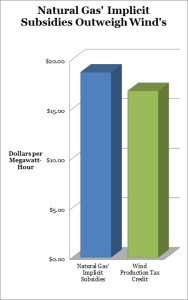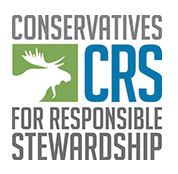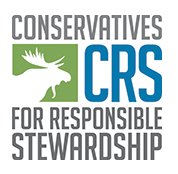Those opposed to extending the production tax credit (PTC) for wind energy justify their position by claiming the need to “level the playing field” and “allow the market, not government, to pick winners and losers.” What they fail to point out, is that the playing field is already laden with oil, gas and coal subsidies that tilt it heavily to the benefit of fossil fuels.
 Natural gas, for example, benefits greatly from two unique tax advantages: the “percentage depletion allowance” and a government-subsidized financing structure known as the “Master Limited Partnership” (MLP). Based on publicly available data, the tax advantages enjoyed by natural gas from both the Depletion Allowance and the MLP can be teased out and converted into an “implicit” PTC. Converting energy subsidies into comparable units allows for an intellectually honest discussion. According to our analysis at Conservatives for Responsible Stewardship, these two subsidies alone provide natural gas with a tax credit equivalent of almost $19 per megawatt hour (MWh) over a 25-year period, which is about $2 per MWh more than what wind energy receives from the PTC.[1]
Natural gas, for example, benefits greatly from two unique tax advantages: the “percentage depletion allowance” and a government-subsidized financing structure known as the “Master Limited Partnership” (MLP). Based on publicly available data, the tax advantages enjoyed by natural gas from both the Depletion Allowance and the MLP can be teased out and converted into an “implicit” PTC. Converting energy subsidies into comparable units allows for an intellectually honest discussion. According to our analysis at Conservatives for Responsible Stewardship, these two subsidies alone provide natural gas with a tax credit equivalent of almost $19 per megawatt hour (MWh) over a 25-year period, which is about $2 per MWh more than what wind energy receives from the PTC.[1]
Although oil and natural gas receive deserved and positive attention for their contribution to jobs and tax revenues, long-held tax incentives mean that the playing field for other energy market participants is far from level. Unlike the subsidy for wind, which Congress must renew over and over, the subsidies for oil and natural gas are permanent.
Access to the MLP has provided the gas industry with tens of billions of tax-free dollars from investors in recent years—illustrating how government subsidies drive investment decisions. Natural gas pipeline businesses structured as MLPs are smartly designed based on the pipeline industry’s business model. Similarly, the PTC is designed to encourage wind energy facilities to maximize wind energy output, which lowers the overall unit cost of energy for consumers (i.e., PTCs are a direct function of energy output). Fortunately, both the MLP and the PTC are tax policies that have a natural operational fit within each industry.
Over the last 17 years, the “implicit” PTC for natural gas at times has been both more than and less than the PTC for wind energy. Nevertheless, the “implicit” PTC for natural gas since 2005 has been higher than that of the “explicit” PTC for wind energy except during the 2008 financial crisis.
All Energy is Subsidized
The skewed justification to eliminate the PTC is particularly faulty when considered in the broader context of wind energy’s role in fostering energy independence and having a diversified energy portfolio. Wind power reduces air pollution and saves water, which is heavily used in other forms of energy production. (A separate energy policy discussion is necessary to determine whether or not these societal benefits from wind energy are worth incentivizing.)
An intellectually honest discussion about energy subsidies begins with acknowledging the fact that all other energy resources are also incentivized. As Ronald Reagan said, “facts are stubborn things.” Opinions can vary on which forms of energy, if any, deserve to be subsidized, but those opinions must first and foremost be informed by the fact that all energy is subsidized.
The only way to ever have a 100 percent subsidy-free energy market is to dramatically overhaul the tax code. Otherwise, the only available means to create a level playing field- for any energy source–is subsidy equivalence.
Master limited partnerships
MLP structures attract capital from individual retail investors at low rates due to their distinct tax advantages and stable cash flows. The main tax advantage derived from accessing the MLP structure is that is allows the natural gas industry (among a few other select industries, including coal) [1] to avoid corporate income taxes on these partnerships. However, the same tax code that confers this special right on natural gas precludes these same MLP investors from investing in wind energy. [2] Due to the value of this government subsidized financing structure known as the MLP, the Internal Revenue Service (IRS) carefully monitors and enforces the myriad rules and regulations necessary to achieve and maintain MLP status.[3]
“Implicit” PTC
Accessing the MLP structure to finance large energy infrastructure projects that provide stable cash flows creates an “implicit” PTC of $16.31 per MWh. Teasing out this energy subsidy involves taking the difference between financing costs for a wind energy facility[4] versus a natural gas pipeline structured as an MLP.[1] Based on average costs and energy production for 2013 wind projects[2], the benefit of having access to the MLP structure creates an “implicit” PTC of $16.31/MWh. Only by doing this kind of analysis is this energy subsidy easily comparable to the PTC for wind energy.
Financing Advantage
Given the limitations in the Tax Code that precludes individuals from economically investing in wind energy facilities, those seeking to finance wind energy facilities must (1) hope that the companies that own and finance wind projects are sufficiently profitable to utilize the tax benefits and (2) compete against low-income housing or other tax-advantaged investments—none of which have anything to do with energy or market fundamentals. An investment structured as a MLP, on the other hand, competes for funding against the return expectations for stocks and bonds in the broader retail capital markets. This subsidy, buried deep in the Tax Code, decreases the financing costs for natural gas infrastructure, which in turn reduces the delivered cost of natural gas to consumers and power plants.
Depletion Allowance
Depletion, which provides a similar benefit to the natural gas industry, has been buried deep in the Tax Code since 1913. This allowance lets most producers of natural gas (and other hydrocarbons) to deduct annually 15 percent of their revenue as an expense—in addition to drilling, operating, and decommissioning costs. This allowance is based on the idea that extracting natural gas from a well causes that land to diminish in value. However, given advancements in extraction techniques, producers of oil and natural gas reserves continue to take Depletion Allowance deductions beyond actual cost recovery. As a result, the cumulative deductions taken over time are likely to be more than the original cost of the mineral lease.
This perpetual reduction in taxes creates an “implicit” PTC of $2.39 per MWh (with natural gas prices at $4.61 per million BTUs). Of course, the higher the spot price of natural gas, the higher the Depletion Allowance subsidy.
Teasing out the “implicit” PTC from the Depletion Allowance involves (1) multiplying the spot price of natural gas by the 15% Depletion Allowance, (2) multiply that deduction by the marginal tax rate (35%) to calculate the lost government revenue, which is the same as a tax credit, and (3) multiply the lost government revenue/tax credit by a “heat rate” of 10 (a utility industry “rule of thumb” to convert a unit of natural gas into a MWh of natural gas-fired electricity).[1] Only by systematically moving through these calculations and conversions is this energy subsidy easily comparable to the PTC for wind energy.
Example:
Assuming the spot price of natural gas is $5/million BTUs (mmbtu), the “implicit” PTC from depletion is $2.63/MWh, as follows:
Step 1: Calculate the Depletion Allowance deduction
$5 x 15% = $0.75
Step 2: Convert the Depletion Allowance deduction into an equivalent tax credit
$0.75 x 35% = $0.263
Step 3: Multiply the lost government revenue/tax credit by the “heat rate”
$0.263 x 10 = $2.63
Production Tax Credits
PTCs, which are adjusted each year for inflation, provides owners of wind energy facilities a tax credit for each MWh of electricity sold during the first 10 years of operations.[2] If the wind facility doesn’t generate actual energy, it doesn’t generate a tax credit for the project’s owners.
Because the Depletion Allowance and access to the MLP structure are available for a natural gas asset’s entire economic life, the value of wind’s “explicit” PTC is properly evaluated over the 25-year economic life of a wind energy facility. Currently, the PTC starts at $23 per MWh. Assuming 2% annual inflation, the value of the PTC over 25 years is about $16.82 per MWh.[3] With an attempt at an apples-to-apples comparison, the “explicit” PTC for wind is roughly $2 per MWh less than the combined “implicit” PTC of $18.70 per MWh that natural gas receives from both the MLP and Depletion Allowance.
Conclusion
Absent comprehensive tax reform that eliminates all government energy subsidies, the only way to make the playing field somewhat level is to extend the PTC for wind energy. Short of that, the government is regressively tilting the playing field toward established fossil fuel resources at the expense of important emerging resources, and ignoring free-market principles in the process.
Andrew Fales, CPA is an energy investment professional and a senior fellow at Conservatives for Responsible Stewardship
Footnotes:
[1] Assumes mid-year discounting [2] Section 7704 of the Internal Revenue Code, as amended (the Tax Code) [3] Most notably Section 469 of the Tax Code. For an excellent overview of the limitations precluding individuals to economically invest in wind energy facilities, see the insightful article written by the highly respected tax attorney, David Burton: Hunting Unicorns: Individuals as Tax Equity Investors (available at http://cdn.akingump.com/images/content/4/4/v4/4462/Project-Perspectives-Newsletter-Summer2012.pdf [4] Section 7704(d)(1) requires that at least 90% of the MLP’s gross income must come from “qualifying sources” such as: interest, dividends, and capital gains; rental income and capital gains from real estate; income and capital gains from natural resources activities; and income from commodity investments [5] Financing costs for wind energy facilities are currently around 9% (based on the author’s industry knowledge and involvement in financing these projects). [6] Financing costs for natural gas pipelines structured as MLPs are currently around 5% (using the yield from the publicly-traded Alerian MLP index (NYSE: AMZX) as a proxy). [7] Wiser, R.; Lantz, E.;Bolinger, M.; Hand, M. (2014); 2013 Wind Technologies Report; Lawrence Berkeley National Laboratory. [8] Table 8.2. Average Tested Heat Rates by Prime Mover and Energy Source, 2007 - 2012; http://www.eia.gov/electricity/annual/html/epa_08_02.htmln [9] Section 45 of the Tax Code [10] Evaluated at a 9% discount rate; See footnote 5, above.

